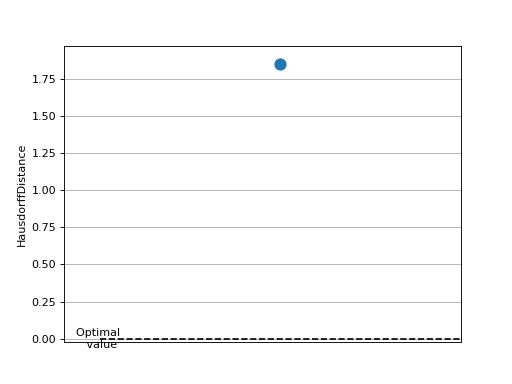Hausdorff Distance¶
Module Interface¶
- class torchmetrics.segmentation.HausdorffDistance(num_classes, include_background=False, distance_metric='euclidean', spacing=None, directed=False, input_format='one-hot', **kwargs)[source]¶
Compute the Hausdorff Distance between two subsets of a metric space for semantic segmentation.
\[d_{\Pi}(X,Y) = \max{/sup_{x\in X} {d(x,Y)}, /sup_{y\in Y} {d(X,y)}}\]where \(\X, \Y\) are two subsets of a metric space with distance metric \(d\). The Hausdorff distance is the maximum distance from a point in one set to the closest point in the other set. The Hausdorff distance is a measure of the degree of mismatch between two sets.
As input to
forwardandupdatethe metric accepts the following input:preds(Tensor): An one-hot boolean tensor of shape(N, C, ...)withNbeingthe number of samples and
Cthe number of classes. Alternatively, an integer tensor of shape(N, ...)can be provided, where the integer values correspond to the class index. The input type can be controlled with theinput_formatargument.
target(Tensor): An one-hot boolean tensor of shape(N, C, ...)withNbeingthe number of samples and
Cthe number of classes. Alternatively, an integer tensor of shape(N, ...)can be provided, where the integer values correspond to the class index. The input type can be controlled with theinput_formatargument.
As output of
forwardandcomputethe metric returns the following output:hausdorff_distance(Tensor): A scalar float tensor with the Hausdorff distance averaged overclasses and samples
- Parameters:
include_background¶ (
bool) – whether to include background class in calculationdistance_metric¶ (
Literal['euclidean','chessboard','taxicab']) – distance metric to calculate surface distance. Choose one of “euclidean”, “chessboard” or “taxicab”spacing¶ (
Union[Tensor,list[float],None]) – spacing between pixels along each spatial dimension. If not provided the spacing is assumed to be 1directed¶ (
bool) – whether to calculate directed or undirected Hausdorff distanceinput_format¶ (
Literal['one-hot','index','mixed']) – What kind of input the function receives. Choose between"one-hot"for one-hot encoded tensors,"index"for index tensors or"mixed"for one one-hot encoded and one index tensorkwargs¶ (
Any) – Additional keyword arguments, see Advanced metric settings for more info.
Example
>>> from torch import randint >>> from torchmetrics.segmentation import HausdorffDistance >>> preds = randint(0, 2, (4, 5, 16, 16)) # 4 samples, 5 classes, 16x16 prediction >>> target = randint(0, 2, (4, 5, 16, 16)) # 4 samples, 5 classes, 16x16 target >>> hausdorff_distance = HausdorffDistance(distance_metric="euclidean", num_classes=5) >>> hausdorff_distance(preds, target) tensor(1.9567)
- plot(val=None, ax=None)[source]¶
Plot a single or multiple values from the metric.
- Parameters:
val¶ (
Union[Tensor,Sequence[Tensor],None]) – Either a single result from calling metric.forward or metric.compute or a list of these results. If no value is provided, will automatically call metric.compute and plot that result.ax¶ (
Optional[Axes]) – An matplotlib axis object. If provided will add plot to that axis
- Return type:
- Returns:
Figure and Axes object
- Raises:
ModuleNotFoundError – If matplotlib is not installed
>>> from torch import randint >>> from torchmetrics.segmentation import HausdorffDistance >>> preds = randint(0, 2, (4, 5, 16, 16)) # 4 samples, 5 classes, 16x16 prediction >>> target = randint(0, 2, (4, 5, 16, 16)) # 4 samples, 5 classes, 16x16 target >>> metric = HausdorffDistance(num_classes=5) >>> metric.update(preds, target) >>> fig_, ax_ = metric.plot()

Functional Interface¶
- torchmetrics.functional.segmentation.hausdorff_distance(preds, target, num_classes, include_background=False, distance_metric='euclidean', spacing=None, directed=False, input_format='one-hot')[source]¶
Calculate Hausdorff Distance for semantic segmentation.
- Parameters:
include_background¶ (
bool) – whether to include background class in calculationdistance_metric¶ (
Literal['euclidean','chessboard','taxicab']) – distance metric to calculate surface distance. Choose one of “euclidean”, “chessboard” or “taxicab”spacing¶ (
Union[Tensor,list[float],None]) – spacing between pixels along each spatial dimension. If not provided the spacing is assumed to be 1directed¶ (
bool) – whether to calculate directed or undirected Hausdorff distanceinput_format¶ (
Literal['one-hot','index','mixed']) – What kind of input the function receives. Choose between"one-hot"for one-hot encoded tensors,"index"for index tensors or"mixed"for one one-hot encoded and one index tensor
- Return type:
- Returns:
Hausdorff Distance for each class and batch element
Example
>>> from torch import randint >>> from torchmetrics.functional.segmentation import hausdorff_distance >>> preds = randint(0, 2, (4, 5, 16, 16)) # 4 samples, 5 classes, 16x16 prediction >>> target = randint(0, 2, (4, 5, 16, 16)) # 4 samples, 5 classes, 16x16 target >>> hausdorff_distance(preds, target, num_classes=5) tensor([[2.0000, 1.4142, 2.0000, 2.0000], [1.4142, 2.0000, 2.0000, 2.0000], [2.0000, 2.0000, 1.4142, 2.0000], [2.0000, 2.8284, 2.0000, 2.2361]])
